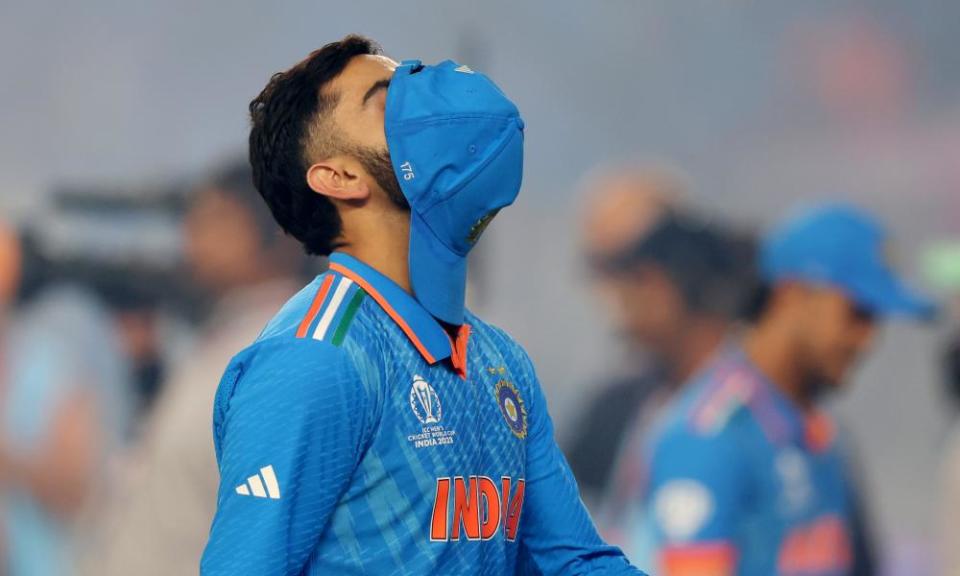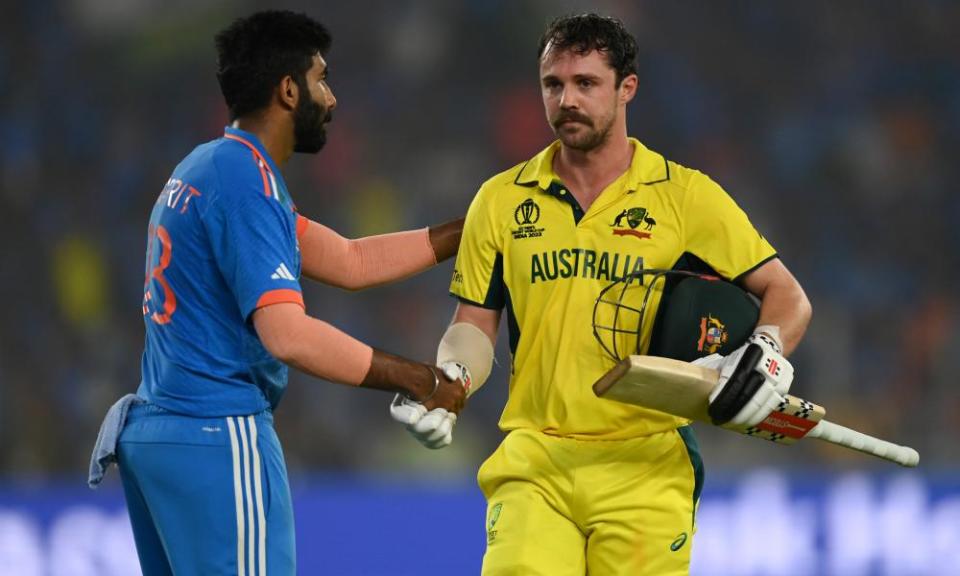Silence defines the day as India’s invincibles crash to cruel final twist

Well, that wasn’t supposed to happen. Stop all the clocks. Rename the stadium. Prevent the DJ from pumping out his relentlessly upbeat musical blurts. On a day of light, fury and also silence, India’s World Cup, the World Cup of the Invincibles, ran out of road at the Narendra Modi Stadium.
This was a piano forte kind of final, a day defined by extremes of noise and silence, expressed in volume rather than pictures, sound rather than light. The start was all noise, from the thrillingly sui generis energy of a 92,453 cricket crowd, to the jets pirouetting in the Ahmedabad sky, to Ravi Shastri’s hype-man shtick at the toss, a feverish, panama-hatted figure, arms revolving like an amphetamine-crazed general in the wreckage of Stalingrad.
Related: Australia earn Cricket World Cup glory as Travis Head ton spoils India’s party
But it was the silences that came to define the day, and which seemed to peel back some of the bombast and fury around this game. The key moment arrived 28 overs into the day with India on 148 for three and the outfield drenched in hot white light under the usual dosa-layer of mist.
Virat Kohli had reached a sedate and chanceless fifty moments before, at a World Cup where he has always seemed to be batting inside a personalised VVIP zone, insulated most of the time by the verve of the batters around him and the power of India’s bowlers. Pat Cummins was in the middle of a wonderful captain’s spell. He pitched back of a length on that Cummins angle, bowling reimagined as a politely sustained physical assault. Kohli was cramped by nip and could only run the ball down on to his stumps, which flared with mocking red light.
Who knew silence could also come in a wave? The Modi went cold, instantly, the air rushing up and out through the roof. The silence of 92,453 people is a remarkable thing, silence as an entity in itself, swallowed noise. Kohli stood, then stood a bit longer, stood for so long there was a sense in retrospect that perhaps his theatrics made the moment more than it might have been.
There is a scientific paper to be written on the optics and the team energy of the batsman’s walk-off. Act out a tragedy and it must be a bit more likely you’re ushering one in. Two hours later Kohli was there again as the loudest noise of the day erupted, taking the catch at second slip as David Warner prodded vaguely at Mohammed Shami, and just for a moment it looked as though Australia’s chase of 241 might be consumed in the ambient energy.
The noise was wonderful, emerging in rolling, tumbling waves, then fusing into one giant field of static. Bodies tumbled in the stands. A previously impassive soldier performed a furious, high-speed fist-pumping dance. This was pure joy, the kind of energy you just want to take a bite out of, hungry for another hit. Cricket doesn’t do this often; or indeed anywhere else. It was an isolated note. The switch was flicked again. Mitch Marsh lifted Shami high over the fence at long-off as plumes of smoke drifted through that densely peopled silence like tumbleweed. At the other end Travis Head began to beat the ball, and beat the energy out of the day, en route to one of the great ODI innings of all time, a match-winning 137 of startling verve and skill.

In the middle of all this the nicest sound of the day was a more gentle, willed, tender thing. With the game sliding away and India’s World Cup already being packed and stitched into its casket, Head reached his hundred with a scampered single. Out of the silence came the most soothing of noises as the blue shirts around the ground stood to applaud, more and more of them as Head leapt and punched the air, sending a generous ripple all the way around the tiers.
At the end defeat was accepted graciously, with fond applause for the winners from those who stayed behind for at least an hour so that Narendra Modi himself could finally turn up to hand over the trophy. If there is a lesson to be learned from a day when the volume veered between 11 and zero, it is a reminder that sport, the most vital commodity here, a little glow of freedom in the increasingly managed world of elite competitions, will still have the final word.
Related: Australia stun India to win Cricket World Cup final – in pictures
Events occur. Anyone can lose a game. A World Cup hosted by the sport’s overwhelmingly dominant power can still fall the other way. The narrative in India has been dominated by Indian victory, Indian joy, the exceptionalism of a team described as having “no weakness”. And rightly so. India have been by far the best team at this tournament. But sport demands a twist, and Australia are the standard here, the default measure of quality. They’re the BMW 3 Series estate, Germany in the 90s, the thing that makes everyone else have to be good enough to beat Australia.
Some will suggest, harshly, that India’s batsmen choked on that pressure as Australia bowled supremely well. Instead it was Head who seized the day, a cricketer who always looks free and rakish, and who can seem even in a World Cup final to be batting at a country picnic.
Marnus Labuschagne was ice cold to the end alongside him. And both Australians were applauded as they hugged on Head’s departure from the crease, by a home crowd stepping outside the matrix of game, country, shirt, and offering up some pure sporting affection.

 Yahoo Sport
Yahoo Sport 






































